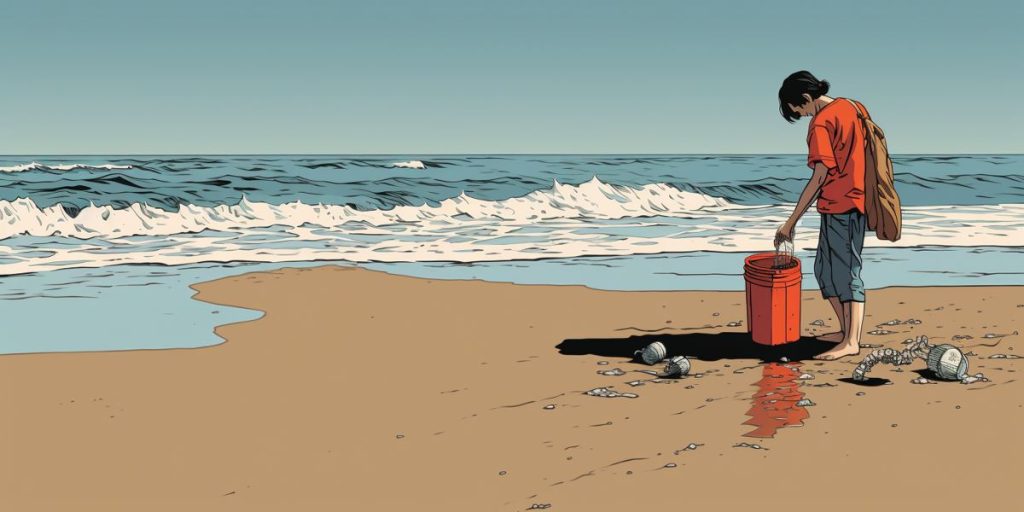Plastic pollution is threatening the beaches of Cyprus, with up to 4000 microplastic particles per square meter found on certain beaches. The AKTI Project and Research Centre is conducting a pioneering study on microplastic pollution, aiming to raise awareness and inspire action to combat this pressing environmental issue.
What is the impact of plastic pollution on Cyprus’s beaches?
Plastic pollution poses a major threat to the environment and marine life on Cyprus’s beaches. Microplastics, tiny plastic pieces, are polluting the sand and water, endangering marine species and potentially affecting human health. A study has found up to 4000 microplastic particles per square meter on certain beaches in Cyprus, prompting urgent conservation efforts.
The Plight of Plastic on Cypriot Shores
Cyprus, the picturesque Mediterranean island, is facing an environmental challenge of significant proportions. Beautiful beaches, a hallmark of this tourist haven, are now home to an unwelcome inhabitant: plastic waste. It’s a material known for its durability, which, paradoxically, is also its curse. Rather than decomposing, plastic breaks down into ever-smaller pieces, known as microplastics, under the influence of elements such as sunlight and water.
These microplastics, some as tiny as a millimeter, are more than just an eyesore on the sand—they’re a danger to marine life and, by extension, to humans. In fact, the presence of microplastics has been confirmed within the tissues of fish, a staple in the diet of coastal communities around the world. The implications are far-reaching, and the issue necessitates urgent attention, especially in areas like Cyprus, where the marine ecosystem plays a crucial role in the region’s biodiversity and economy.
A Pioneering Study on Microplastic Pollution
Acknowledging the severity of the issue, the AKTI Project and Research Centre, backed by Columbia Shipmanagement Ltd, has embarked on a groundbreaking three-year field study. This research is the first of its kind in Cyprus and involves meticulous data collection from both remote and popular beaches across the island. The process is rigorous, involving sieving, flotation, and microscopic analysis of beach sediments.
Initial findings have been alarming, with up to 4000 microplastic particles per square meter detected on certain beaches. These particles are not uniform; they come in various sizes, colors, and shapes, from pellets to films. This diversity indicates a wide range of plastic products breaking down and making their way to the sea.
After completing the first year of sampling, the research team has identified the five beaches with the highest levels of microplastic accumulation. The upcoming years of the study will see increased sampling frequency to understand seasonal variations and the influence of marine currents on the dispersal of these plastics.
The Future of Cyprus’s Coastal Conservation Efforts
The data generated by this study is invaluable, shining a light on the current situation and informing future conservation efforts. These efforts are not just about keeping the beaches clean; they are about ensuring the health of the marine environment and, by extension, the health of people. The research conducted by the AKTI Project and Research Centre signifies a crucial step toward a broader goal—a cleaner, plastic-free Mediterranean.
As the project progresses, it is hoped that the findings will galvanize local and regional action to address the plastic problem. Awareness is the first step, but it must be followed by tangible changes in policy, waste management, and public behavior. Only by working together can we hope to restore the natural beauty and ecological balance of Cyprus’s beaches.
What is the impact of plastic pollution on Cyprus’s beaches?
Plastic pollution poses a major threat to the environment and marine life on Cyprus’s beaches. Microplastics, tiny plastic pieces, are polluting the sand and water, endangering marine species and potentially affecting human health. A study has found up to 4000 microplastic particles per square meter on certain beaches in Cyprus, prompting urgent conservation efforts.
What are microplastics and how do they affect marine life?
Microplastics are small plastic particles, often less than a millimeter in size. They are created when larger plastic items break down into smaller pieces due to exposure to elements like sunlight and water. These microplastics can be ingested by marine animals, leading to various negative impacts such as blockage of their digestive systems, reduced feeding abilities, and potential transfer of toxic chemicals up the food chain. The presence of microplastics has been confirmed within the tissues of fish, which can have implications for both the marine ecosystem and human health.
How is the AKTI Project and Research Centre addressing plastic pollution in Cyprus?
The AKTI Project and Research Centre, with the support of Columbia Shipmanagement Ltd, is conducting a pioneering three-year field study on microplastic pollution in Cyprus. The study involves meticulous data collection from beaches across the island, utilizing sieving, flotation, and microscopic analysis of beach sediments. The initial findings have been alarming, with up to 4000 microplastic particles per square meter detected on certain beaches. The research aims to raise awareness about the issue and inform future conservation efforts.
What can be done to combat plastic pollution in Cyprus?
Combating plastic pollution in Cyprus requires a multi-faceted approach. Some possible actions include:
- Raising awareness: Spreading knowledge about the issue among the public, local communities, and policymakers is crucial to drive change.
- Improving waste management: Implementing effective waste management systems, including recycling and proper disposal of plastic waste, can help reduce plastic pollution.
- Encouraging sustainable practices: Promoting the use of reusable bags, bottles, and other items can help reduce the consumption of single-use plastics.
- Supporting research and innovation: Investing in research and innovative solutions can lead to new ways of tackling plastic pollution and developing sustainable alternatives.
It is important for individuals, communities, businesses, and governments to work together to address this pressing environmental issue and protect the beautiful beaches of Cyprus.

